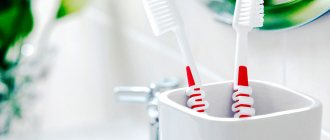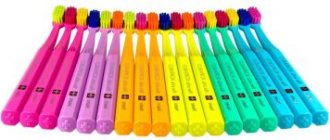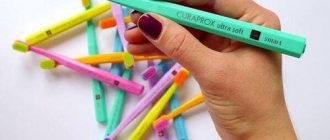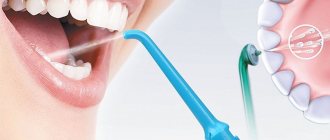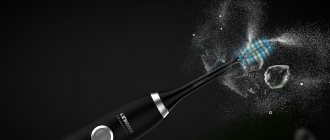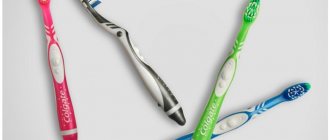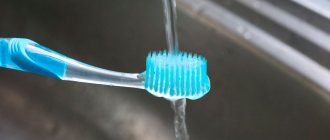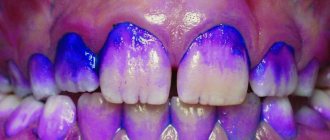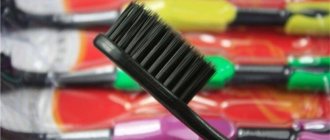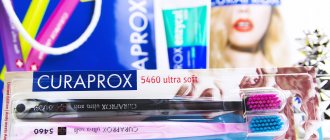In this article
- Classification of toothbrushes
- Classification of electric toothbrushes
- Choosing toothbrush bristles
- Selecting cleaning head parameters
- What influences the location of the fiber bundles?
- How to make the right choice?
The main tool that has allowed us to remove plaque from the surface of our teeth for centuries is the toothbrush. During its existence, this hygiene item has undergone numerous transformations, maintaining its main function - the cleanliness of the oral cavity. We will tell you what modern toothbrushes are like in this article.
Classification of toothbrushes
Today, the toothbrush market offers a huge range of models that differ in design, cleaning technology, material and other parameters. A clear classification helps to understand this diversity.
The most accurate, complete and modern classification is that of Honored Dentist, Doctor of Medical Sciences, Professor of Medical University and Academician of PANI S.B. Ulitovsky.
According to his classification, brushes are:
- children, teenagers and adults;
- hygienic, preventive and additional;
- manual, electrical and mechanical;
- straight and angular, with and without indication;
- artificial and natural bristles;
- one-, two-, three- and multi-level according to the nature of the arrangement of the beams;
- cut, rounded, polished, ground, combined (according to the degree of bristle processing);
- setron, nylon, perlon, derolon, polyurethane, combined - according to the bristle material;
- very soft, soft, medium hard, hard, very hard, mixed and combined - according to the stiffness of the bristles;
- with flat, narrow, thin, round, combined, mixed, hard and springy handles;
- small, medium and large - depending on the size of the handle;
- with corrugated, flat, concave, convex, horizontal, mixed, circular, vertical, universal, special, combined, mixed and without grip.
It can be difficult to understand such diversity without the help of a dentist, so we recommend consulting with your doctor.
Classification of electric toothbrushes
Today, electric toothbrushes are gaining popularity and may soon supplant regular manual ones. Their advantage is the high cleaning efficiency, which is possible thanks to the rapid movements and pulsations of the bristles. It is impossible to achieve this effect manually, so electric brushes are better than conventional ones at removing tartar, plaque, and cleaning hard-to-reach areas.
Electric toothbrushes have a built-in motor and a rechargeable battery or battery that allows them to operate autonomously.
Electric brushes, depending on their design and technology, are divided into three main types:
- Rotary.
- Sound.
- Ultrasonic.
The simplest among electric brushes are rotary ones. Their cleaning head rotates at high speed, providing mechanical removal of plaque and food debris from the surface of the teeth. They are accessible to users of any budget and are easy to use, but at the same time clean teeth better than manual brushes.
An example of high-quality rotational models is the B.Well MED-810 or CS Medica CS-465-M.
The operation of sonic brushes is based on more complex technology. The high-frequency generator creates a sound wave that causes the bristles of the cleaning head to pulsate at a high frequency. Thanks to such pulsations, the sonic brush not only removes plaque well, but also creates fine foam with oxygen bubbles in the mouth. By bursting, they remove contaminants in the most difficult areas of the oral cavity. In addition, the sonic brush gently massages the gums, is suitable for caring for braces, implants, and allows you to carefully clean gum pockets. Here are some great models: Panasonic EW-DL82-W820, CS Medica CS-161.
The ultrasonic model is similar to the sound one, the only difference being that it does not generate audible sound vibrations, but high-frequency ultrasound. It effectively destroys even complex pigmented plaque, penetrates hard-to-reach places, has a healing effect on the gums, and increases their permeability to toothpaste components. Popular models of ultrasonic brushes are Megasonex, Donfeel.
It should be taken into account that electric brushes have a number of contraindications and are not suitable for young children, so it is not recommended to use them without first consulting a dentist.
A few more recommendations from experts
To get the maximum effect from each procedure, you should follow the correct teeth brushing technique. Movements should not be horizontal, but vertical - this applies to the front incisors and canines. Back teeth can be brushed horizontally, but special attention must be paid to the chewing surface. To maintain the proper level of hygiene, you should also rinse your mouth after each meal, use dental floss and purchase an irrigator. This is a small device that delivers a stream of water and air under high pressure to more accurately clean hard-to-reach areas.
- Baluda M.I. Clinical and laboratory assessment of the effectiveness and quality of toothbrushes, 2012.
Choosing toothbrush bristles
The quality, material, length and other characteristics of the bristles of a toothbrush directly determine the effectiveness of oral hygiene.
There is a myth that everything natural is better than artificial. When applied to toothbrush bristles, this is not true. Natural ones have more disadvantages than advantages. They have a porous structure and a median channel in which bacteria accumulate and multiply, and they are also hard and severely scratch the gums. Artificial bristles are smooth, have no pores, dry quickly and are less susceptible to contamination by microorganisms, therefore they are considered safer. Modern materials for toothbrushes are soft and do not damage tooth enamel and gum surfaces when brushing.
The most important characteristic to pay attention to is the stiffness of the bristles. How to choose the right one for yourself?
- Sensitive.
This is a very soft bristle that has the most delicate effect on the oral cavity. This type of toothbrush is recommended for brushing teeth in case of inflammatory periodontal diseases.
- Software
Soft bristles are suitable for cleaning children's teeth, caring for sensitive gums and thin enamel. Dentists often recommend this type of brush for pregnant women and people with diabetes. In these conditions, there is often swelling, soreness of the gums and high vulnerability of the tissues surrounding the tooth, due to hormonal changes.
- Medium.
A medium-hard brush is suitable for the vast majority of people with healthy teeth. It provides a moderately strong effect on teeth and gums, effectively removing plaque without causing pain or discomfort.
- Hard.
The stiff bristles help remove stubborn plaque and are suitable for effective cleaning of removable dentures.
- Extra hard.
Very hard brushes should only be used as prescribed by a dentist, as they increase the risk of injury to the gums and damage to the enamel. This toothbrush is used if you are prone to stone formation.
Many toothbrush manufacturers combine bristles of different hardnesses into one model. For example, the central bristles are made more rigid for high-quality cleaning of chewing surfaces, and the side bristles are made softer for careful removal of dirt along the gum edge.
In addition to the stiffness of the bristles, the degree of processing is important. Most modern brushes have rounded bristles to prevent injury to the gums. Brushes with pointed bristles are less common - they penetrate well into the interdental spaces, but can damage soft tissues.
Functional purpose
Toothbrushes are not only a hygiene item for healthy teeth, but also act as an auxiliary element in the treatment and prevention of various pathological conditions. The following functional types of toothbrushes exist:
- Hygienic brushes recommended for daily use, daily cleaning of the oral cavity from food debris, bacteria and plaque.
- Preventive toothbrushes with soft bristles, which are used for hygiene by patients with periodontitis after surgery.
- Toothbrushes for special purposes, which have a special specific arrangement of bristles. Such instruments are used by patients when installing braces or orthodontic structures.
Selecting cleaning head parameters
The main functional part of a toothbrush is the head, so you should choose it very carefully. It is believed that models with a small cleaning head are more effective at removing plaque and other contaminants. With their help, you can clean hard-to-reach areas, distant teeth, including wisdom teeth. A large cleaning head is less effective at such tasks because its size makes it difficult to control.
The size of the cleaning head is selected based on the age of the user:
- Children's brushes have an optimal length of the working part of 18-25 mm and a width of 7-9 mm.
- Adults are 25-30 mm long and 7.5-11 mm wide.
When choosing the optimal size of the cleaning head, ensure that it covers a maximum of 2-3 teeth. In addition to length and width, the number of tufts of bristles differs between cleaning heads. In children's models there should be 23, in teenagers - 39-40, in adults - 48-55.
It is better to give preference to round cleaning heads. They are considered safer and more maneuverable. Rectangular heads are more bulky and can damage the oral mucosa, so they should not be chosen for children, and adults should use them with caution.
Dentists recommend changing your toothbrush every 2-3 months, because over time, germs accumulate on it, and wear of the bristles reduces the quality of cleaning by 50%. To remember to change your toothbrush promptly, you can choose a model with an expiration indicator: as it wears, its colored bristles will lose color.
How to properly care for the product
In order for the product to serve you as long as possible, it should be stored properly and kept clean. Here are some basic recommendations in this regard:
- Obviously, each member of the family should have his own brush. Devices can be stored in a cup specially designated for this purpose, but care must be taken that the working areas do not come into contact with each other,
- they should be kept separate from razors and other hygiene items,
- The model for mechanical cleaning and the nozzle for electric/ultrasonic cleaning must be changed every 3 months. After treating caries or mucosal infections, you should buy a new product,
- After each procedure, it is recommended to thoroughly wash the bristles and treat them with soap - leave this until the next cleaning.
Everyone should have their own personal toothbrush.
A closed case is not the best solution for permanent storage. Only if it is not a special ventilated case for an electric or ultrasonic model. Once a week, the product can be placed in an antibacterial bath for disinfection.
What influences the location of the fiber bundles?
To care for interdental spaces and clean hard-to-reach areas under braces, a so-called mono-beam brush is used. It has only one bunch of thin, flexible bristles, thanks to which it can penetrate problem areas and perfectly remove plaque.
Most toothbrushes for standard oral care have several dozen tufts, which can be arranged in several rows (usually three or four). More effective cleaning is provided by those models in which the height of the beams in different rows is different. If there are short bristles in the center and long bristles at the edges, then the former perfectly remove plaque in the central grooves of the teeth, and the latter remove plaque from the surfaces of the teeth and interdental spaces. The oblique arrangement of the beams facilitates better penetration of the brush under the periodontal margin and cleansing of the cervical area.
How to make the right choice?
The classification of toothbrushes clearly shows how great their diversity is. To make the right choice for your oral health, you need to know the condition of your teeth and gums. Therefore, it is advisable to discuss the choice of a brush for yourself or your child with your dentist after a thorough examination of the oral cavity. The specialist will recommend which toothbrush model can most effectively solve individual hygiene problems and advise additional oral care products.
You can always purchase a high-quality toothbrush and other oral hygiene products in our online store.
How to choose the right brush
We have looked at the main characteristics of various toothbrush options, and now let’s move on to specific recommendations on how to correctly evaluate the quality and effectiveness of products. Let's talk separately about the choice for adults and children.
Recommendations for adult patients
When considering various options, you need to pay attention to criteria such as the degree of rigidity, the position of the bristles, their length and number. Moreover, the shape and length of the handle are also selected taking into account the condition of the teeth and gums, and the patient’s age. It is best to talk to your dentist in advance and get professional recommendations in this regard. The simplest and best option in terms of price and efficiency would be a conventional mechanical brush with synthetic bristles made of nylon. Natural bristles become dirty faster, bacteria accumulate in them, multiply and quickly render the tool unusable.
It is better if there is a ribbed surface on the back of the working area - it is intended to clean the tongue, which, by the way, accumulates the most bacteria. If you have the financial means and there are no problems with enamel sensitivity, you can give preference to an electric or ultrasonic model. We’ll talk more about assessing rigidity, material and size in the next section, but for now let’s move on to choosing the most suitable option for the child.
The ribbed surface on the back of the brush will help clean your tongue.
How to choose a brush for a child
By the age of 1.5-2 years, a baby usually already has about 15 teeth in his mouth. This is the best time to start getting him into the habit of brushing his teeth regularly twice every day. In this case, it is necessary to show the child to a specialist as soon as his first teeth begin to cut. And even before they appear, you should keep the baby’s mouth clean by regularly wiping the gums and mucous membranes using special finger wipes.
When a sufficient number of teeth appear, parents will be faced with the question: which brush is best to buy for their child. To avoid making a mistake with your choice, pay attention to the following points:
- appearance – the baby needs to be interested, and a bright, attractive design will help with this. With a brush of an unusual shape and colorful colors, the child will be more willing to brush his teeth every morning and evening,
- bristle parameters - for baby teeth, you need to ensure uniform pressure, and in this regard, even bristles are the best option. Length – no more than 11 mm. Medium and soft hardness is suitable for children - in this regard, you need to consult a dentist to take into account the current state of the enamel,
- working area - the head should not be too large, otherwise it will be uncomfortable to use and there will be a risk of damaging the mucous membrane. The working area should cover 2-3 children's teeth, and it is better to give preference to a round shape,
- handle – should be comfortable, optimal size for a child’s hand. It is better if it is covered with non-slip material. As you grow older, the length of the handle should increase.
Be responsible when choosing a toothbrush for your child.
Experts in the field of pediatric dentistry pay special attention to the change in primary occlusion. During this period, it is better to purchase a brush with multi-level bristles. The product must be replaced with a new one every 3 months.
